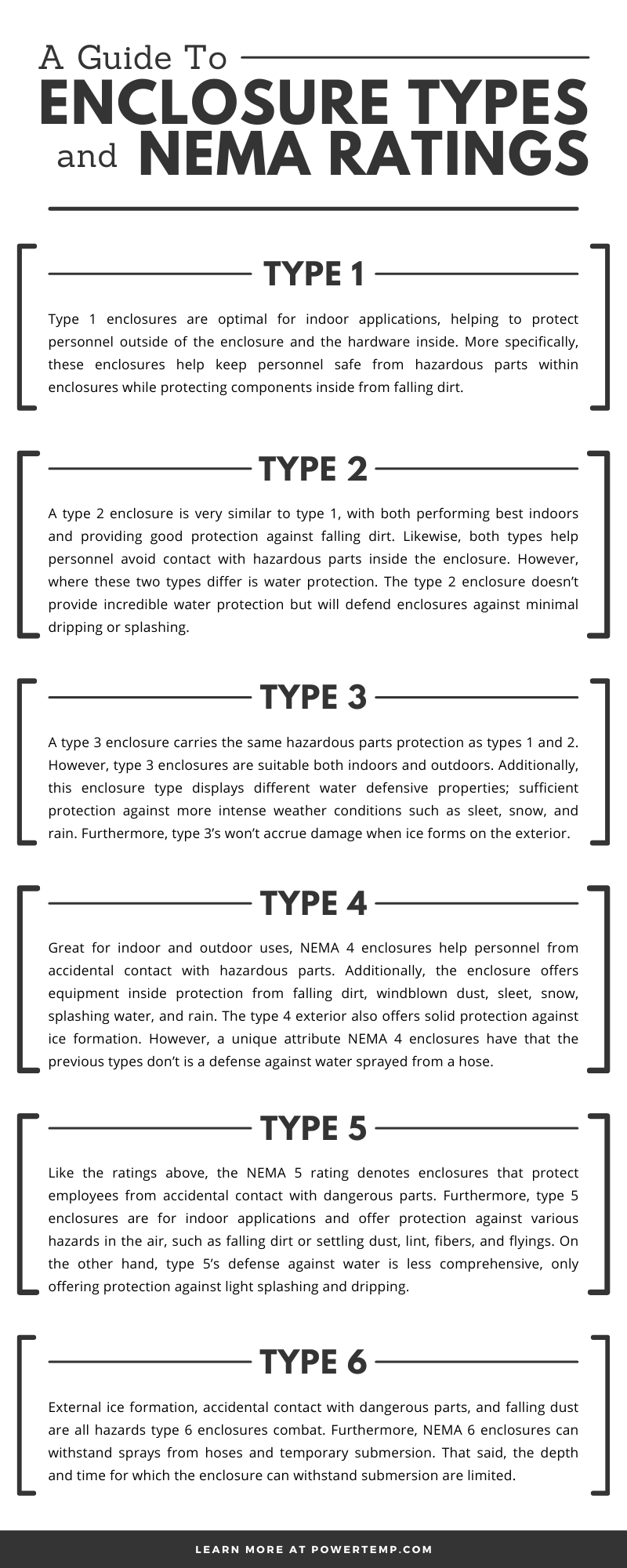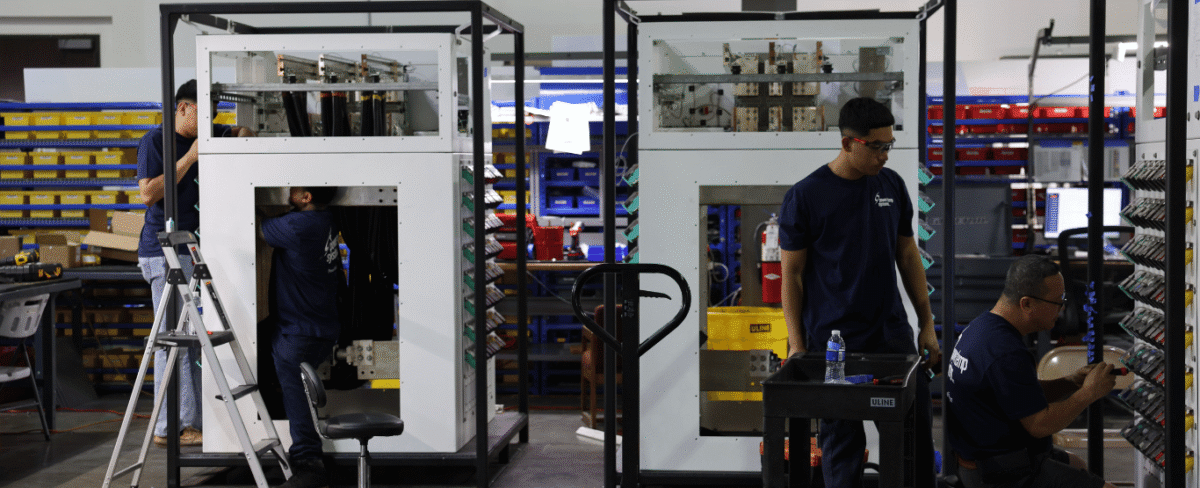Read this guide to enclosure types and NEMA ratings so you can ensure your electrical equipment meets the proper standards and fits your application.
The National Electrical Manufacturers Association (NEMA) creates standards for electrical equipment, including enclosures. The enclosure “type” refers to the types of conditions under which they provide optimal performance. When NEMA applies a rating of 1,2, etc., it signifies what type of enclosure it is. Don’t worry; a guide to enclosure types and NEMA ratings, which you’ll find below, should clear up any questions or confusion you have on the topic.
Type 1
Type 1 enclosures are optimal for indoor applications, helping to protect personnel outside of the enclosure and the hardware inside. More specifically, these enclosures help keep personnel safe from hazardous parts within enclosures while protecting components inside from falling dirt.
Type 2
A type 2 enclosure is very similar to type 1, with both performing best indoors and providing good protection against falling dirt. Likewise, both types help personnel avoid contact with hazardous parts inside the enclosure. However, where these two types differ is water protection. The type 2 enclosure doesn’t provide incredible water protection but will defend enclosures against minimal dripping or splashing.
Type 3
A type 3 enclosure carries the same hazardous parts protection as types 1 and 2. However, type 3 enclosures are suitable both indoors and outdoors. Additionally, this enclosure type displays different water defensive properties; sufficient protection against more intense weather conditions such as sleet, snow, and rain. Furthermore, type 3’s won’t accrue damage when ice forms on the exterior.
Type 3 enclosures also provide additional protection against foreign objects, keeping falling dirt and windblown dust from entering.
Type 3R
Next, we’ll discuss a variation of the type 3 enclosure, the type 3R. This NEMA enclosure carries virtually the same attributes as type 3, except when it comes to protecting equipment inside the enclosure from incoming foreign objects. Although type 3R enclosures can protect equipment from falling dirt, they won’t be as reliable for keeping gear safe from incoming windblown dust. Nevertheless, thanks to their defensive qualities, we offer NEMA type 3R enclosures for our custom power distribution equipment.
Type 3S
The NEMA 3S rating signifies enclosures with almost all the same defensive attributes of a type 3 enclosure. Where these two types differ is in the ice protection department. When ice forms on the exterior of 3S enclosures, external mechanisms must remain functional.
Type 3X
Another member of the NEMA 3 family is the type 3X. NEMA 3X ratings mean you’re using an enclosure with the same defensive qualities of type 3, with one additional benefit. The type 3X enclosure offers ample protection against corrosion.
Type 3SX
As the name suggests, this NEMA rating denotes enclosures taking qualities from the type 3S and 3X enclosures. The main differences between the two aforementioned ratings and the 3SX type are in the ice and corrosion department. 3SX enclosures offer protection against corrosion, like the 3X, though external mechanisms must be operable when ice forms.
Type 3RX
A combination of the type 3R and 3X enclosures, 3RX is great for indoor and outdoor applications. All three types provide protection against exterior ice formation and contact with sleet, snow, and rain. Additionally, like the type 3R, 3RX enclosures keep falling dirt and personnel from accidentally contacting internal components. Another attribute the 3RX takes from the 3R is impressive corrosion resistance. For these reasons, at Power Temp Systems, we offer 3RX enclosures in our quick connect panel lineup.
Type 4
Great for indoor and outdoor uses, NEMA 4 enclosures help personnel from accidental contact with hazardous parts. Additionally, the enclosure offers equipment inside protection from falling dirt, windblown dust, sleet, snow, splashing water, and rain. The type 4 exterior also offers solid protection against ice formation. However, a unique attribute NEMA 4 enclosures have that the previous types don’t is a defense against water sprayed from a hose.
Type 4X
A type 4X enclosure is nearly identical to a type 4. However, the former lacks protection against falling dirt that the latter has. That said, a NEMA 4X enclosure has the benefit of corrosion resistance, unlike type 4.
Type 5
Like the ratings above, the NEMA 5 rating denotes enclosures that protect employees from accidental contact with dangerous parts. Furthermore, type 5 enclosures are for indoor applications and offer protection against various hazards in the air, such as falling dirt or settling dust, lint, fibers, and flyings. On the other hand, type 5’s defense against water is less comprehensive, only offering protection against light splashing and dripping.
Type 6
External ice formation, accidental contact with dangerous parts, and falling dust are all hazards type 6 enclosures combat. Furthermore, NEMA 6 enclosures can withstand sprays from hoses and temporary submersion. That said, the depth and time for which the enclosure can withstand submersion are limited.
Type 6P
A 6P enclosure differs from type 6 in two crucial ways. First, the former has corrosion resistance, unlike type 6. Additionally, 6P’s can handle prolonged submersion in water, though the depths you can submerge 6P’s still aren’t unlimited.
Type 7, 8, and 9
The NEMA 7 enclosure is very different than all previous types, focusing more on explosion protection. A NEMA rating of 7 denotes enclosures capable of containing internal explosions to protect nearby personnel. On the other hand, NEMA 8 enclosures prevent explosions thanks to the inclusion of oil-immersed equipment, whether indoors or outdoors. Falling in line with its predecessors, a type 9 enclosure prevents combustible dust from igniting in indoor work environments.
Type 10
Like NEMA 7, a NEMA 10 rating denotes enclosures capable of containing internal explosions while preventing external damage. The difference with type 10 enclosures is that they meet the standards of Mine Safety and Health Administration, 30 CFR, Part 18, which covers the use of electric motor-driven mining gear.
Type 12
NEMA 12 enclosures specifically lack knockouts and are suitable for indoor applications. With this enclosure, you can expect protection against accidental contact with dangerous internal components, dripping water, light splashing, and circulating dust, lint, fibers, and flyings in the air.
Type 12K
Much like type 12 enclosures, type 12K protects personnel from dangerous parts. Likewise, it protects internal components from all the hazards mentioned in the previous point. The only difference with 12K enclosures is the inclusion of knockouts.
Type 13
Finally, our guide to enclosure types and NEMA ratings ends with type 13. NEMA 13 enclosures can keep employees safe from dangerous internal components while keeping those same components safe from falling dirt, dripping water, light splashing, and circulating dust, fibers, lint, or flyings. An extra attribute of NEMA 13 is protection against any spraying, splashing, or seepage from oil or non-corrosive coolants.


